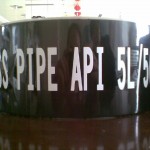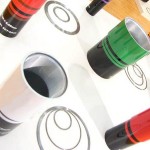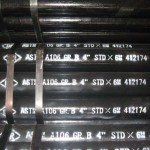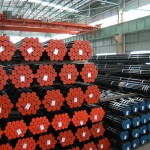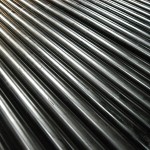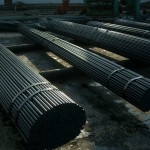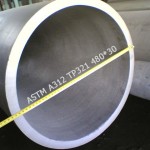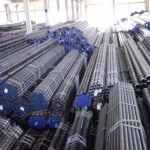Line pipe

Line pipe is a type of steel pipe that is used for transporting materials through pipelines across the country. Line pipe can be used to transport petroleum, natural gas, oil, and water. It is a durable pipe that must meet certain specifications and regulations. This pipe typically has a high strength and durability in order to withstand high pressures. At HYSP QCCO China Steel, we sell and distribute line pipe in a complete variety of sizes, lengths, diameters, and grades.
Standard: API SPEC 5L ISO3183.1 ISO3183.2 ISO3183.3
Usage: Used for oil,natural gas,industrial water,oxygen convey
Steel Grade: X42、X52、X60、X65、X70,X80
L245,L290,L320,L360,L390,L415,L480
|
Seamless steel tubes for pipeline service
|
|||||
|
Variety
|
Specification
|
Steel Grade
|
Executive Standard
|
Typical applications
|
|
|
OD(mm)
|
WT(mm)
|
||||
|
Fluid Pipe
|
48-1200
|
3.5-120
|
10#/20#/Q295/Q345
|
GB/T8163
|
Convey Gerneral Liquid and Gas
|
|
Seamless pipe line
Pipeline for oil
and natural gas
|
L245 L290 L320
L360 L390 L415L450 L480 |
GB/T9711.1 GB/T9711.2
GB/T9711.3 ISO3183-1 ISO3183-2 ISO3183-3 |
Used as oxygen, water, and oil delivery pipe in oil and natural gas industry. |
||
|
A B C X42
X46 X52 X56 X60 X65 X80 |
API SPEC 5L
|
||||
|
B C
|
ASTMA53 ASTMA106
|
||||
| Remarks: we also can produce it according to customer’s requirements. |
|||||
What is Line pipe?
What is Line PipeLine pipe is a type of pipe that is manufactured from high strength carbon steel. It is typically made according to metallurgical specifications that were developed by the American Petroleum Institute (API). Line pipe can be used to build pipelines that transport a variety of resources including natural gas, oil, petroleum, and water. This pipe is available in a variety of diameters ranging from 2 inches to 48 inches. Line pipe can include either seamless or welded carbon steel or stainless steel piping. Because line pipe needs to withstand high pressures, there are important tests done on line pipe to ensure it meets all of the requirements of steel chemistry, strength, toughness, and dimensional characteristics. Using line pipe that meets the set criteria will ensure safe and reliable pipeline service.The size and diameter of line pipe that is required for a pipeline can vary based on the amount of gas or liquid that a pipe is intended to carry as well as the pressures that a line pipe must withstand. For example, in most cases a mainline, the principal pipeline that delivers natural gas, will require line pipe that is around 16 to 48 inches in diameter. Smaller pipelines that deliver gas to the mainline or take gas from a mainline can be constructed of 6 to 16 inch diameter line pipe. One can determine the necessary diameter required for a pipeline by considering the volume of gas or liquid that the line pipe will be carrying as well as the pressure at which this will be transported. The thickness requirements for line pipe are determined by the maximum operating pressure required for a pipeline. This is based on published standards and federal regulations. Following proper safety regulations when selecting and installing line pipe, will ensure proper pipeline operation and prevent dangerous or hazardous situations.
Mechanical Property:
| Standard | Model | Tensile Strength(MPa) | Yield Strength(MPa) | Yield Strength Ratio |
Tensile Stretch(%) | Ballistic Work Akv(J) |
Heat Treatment State |
| API SPEC 5L GB/T9711.2 |
B | ≥415 | 245~440 | ≤0.80 | 22 | ≥40 | normalizing |
| X42 | ≥415 | 290~440 | ≤0.80 | 21 | ≥40 | normalizing | |
| X52 | ≥460 | 360~510 | ≤0.85 | 20 | ≥40 | normalizing | |
| X60 | ≥520 | 415~565 | ≤0.85 | 18 | ≥40 | normalizing | |
| X65 | ≥535 | 450~570 | ≤0.90 | 18 | ≥40 | quencher backfire | |
| X70 | ≥570 | 485~605 | ≤0.90 | 18 | ≥40 | quencher backfire |
Mechanical Property:
| Standard | Model | Chemical Constituent(%) | CEV(%) | |||||||
| C | Si | Mn | P | S | V | Nb | Ti | |||
| API SPEC 5L GB/T9711.2 |
B | ≤0.16 | ≤0.40 | ≤1.10 | ≤0.020 | ≤0.010 | - | - | - | ≤0.42 |
| X42 | ≤0.17 | ≤0.40 | ≤1.20 | ≤0.020 | ≤0.010 | ≤0.05 | ≤0.05 | ≤0.04 | ≤0.42 | |
| X52 | ≤0.20 | ≤0.45 | ≤1.60 | ≤0.020 | ≤0.010 | ≤0.10 | ≤0.05 | ≤0.04 | ≤0.45 | |
| X60 | ≤0.21 | ≤0.45 | ≤1.60 | ≤0.020 | ≤0.010 | ≤0.15 | ≤0.05 | ≤0.04 | agreement | |
| X65 | ≤0.16 | ≤0.45 | ≤1.60 | ≤0.020 | ≤0.010 | ≤0.06 | ≤0.05 | ≤0.06 | ≤0.45 | |
| X70 | ≤0.16 | ≤0.45 | ≤1.70 | ≤0.020 | ≤0.010 | ≤0.06 | ≤0.05 | ≤0.06 | ≤0.45 | |

